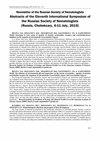The mature and immature spermatozoa of the free-living marine nematode Daptonema sp. (Nematoda: Monhysterida: Xyalidae)
IF 0.3
4区 生物学
Q3 ZOOLOGY
引用次数: 1
Abstract
The immature spermatozoa stored in the testis and female postvulval uterine sac (PUS), and mature spermatozoa from the uterus of the free-living marine nematode Daptonema sp. (Monhysterida: Monhysterina: Xyalidae) were studied. The spermatozoa have a nucleus without a nuclear envelope. The central cytoplasm of the immature spermatozoa from the testis and the distal part of the PUS is occupied by a mass of pale fibrous bodies (FB) surrounded by mitochondria and osmiophilic membranous organelles (MO). The spermatozoa in the proximal half of PUS have a wide peripheral layer of electron lucent filamentous cytoplasm. The uterus lumen contains an aggregation of mature spermatozoa of which the periphery is transformed into pseudopods. The FB replaced by a voluminous electron-lucent halo bounded by a continuous layer of MO, mitochondria and fibrous matter. The MO may be intact, but numerous MO are fused with the plasma membrane, having been transformed into transparent pouches, each one opening to the exterior via a pore. Ultrastructural data showed that the activation is regulated in the female when spermatozoa migrate toward the uterus and transform into amoeboid mature spermatozoa. In general, the spermatozoa of Daptonema sp. and some other Monhysterina closely resemble those of the taxa belonging to the order Rhabditida. However, the `rhabditid' pattern of spermatozoon structure and development is most likely the plesiomorphic state in Rhabditida and close sister groups.自由生活的海洋线虫Daptonema sp.的成熟和未成熟精子(线虫纲:单胞虫纲:木线虫科)
研究了储存在睾丸和雌性外阴后子宫囊(PUS)中的未成熟精子和自由生活的海洋线虫Daptonema sp. (Monhysterida: Monhysterina: Xyalidae)子宫中的成熟精子。精子有一个没有核膜的细胞核。来自睾丸的未成熟精子的中央细胞质和脓液的远端部分被一团苍白的纤维体(FB)所占据,这些纤维体被线粒体和亲锇膜细胞器(MO)所包围。卵泡近半处的精子周围有一层宽的电子光亮丝状细胞质。子宫腔内有成熟精子的聚集,其外围已转化为伪足。FB被一个由MO、线粒体和纤维物质组成的连续层包围的巨大的电子光晕所取代。MO可能是完整的,但许多MO与质膜融合,变成透明的小袋,每个小袋通过一个孔向外开放。超微结构数据显示,当精子向子宫迁移并转化为变形虫成熟精子时,雌性的激活受到调节。一般来说,Daptonema sp.和其他一些Monhysterina .的精子与Rhabditida目的分类群非常相似。然而,精子结构和发育的“横纹肌”模式最有可能是横纹肌和近亲类群的半胚状态。
本文章由计算机程序翻译,如有差异,请以英文原文为准。
求助全文
约1分钟内获得全文
求助全文
来源期刊
CiteScore
2.30
自引率
0.00%
发文量
0
审稿时长
>12 weeks
期刊介绍:
The Russian Journal of Nematology is an English language journal which publishes original research papers on all aspects of Nematology.
The Russian Journal of Nematology is published biannually and each volume normally contains 160 pages.
The Russian Journal of Nematology does not impose page charges for publication of scientific papers.
The Russian Journal of Nematology is an essential source of information for nematologists on the current and varied research being done in laboratories in the CIS and elsewhere.
The Russian Journal of Nematology policy is to stimulate international cooperation in Nematology.
The Russian Journal of Nematology is a non profitable journal, which supported by RSN members, subscribers and sponsors.

 求助内容:
求助内容: 应助结果提醒方式:
应助结果提醒方式:


